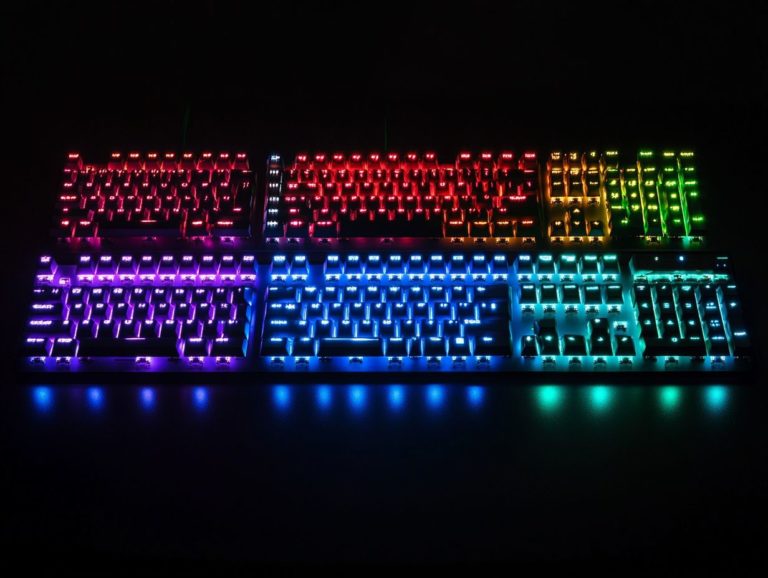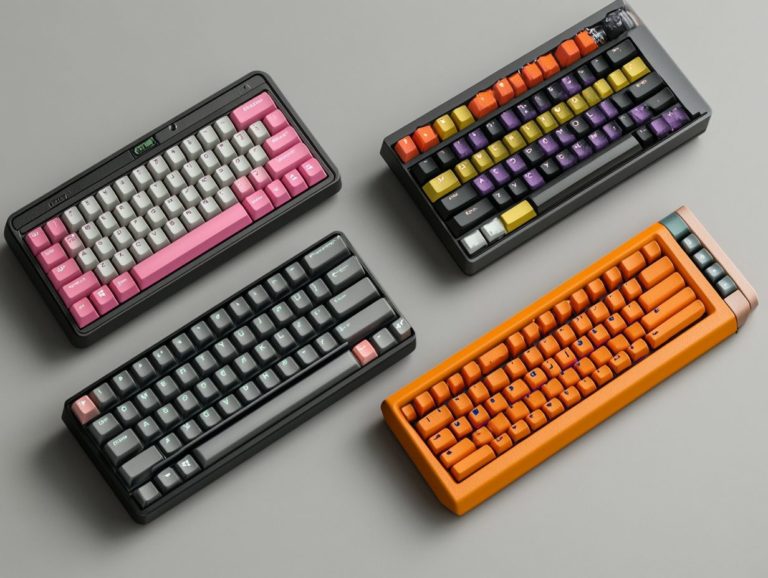exploring the benefits of tactile keyboards
Tactile keyboards transcend mere typing tools; they elevate your entire experience, whether you’re immersed in work, gaming, or leisurely browsing.
With their unique feedback and ergonomic design, these keyboards provide distinct advantages such as enhanced accuracy and diminished fatigue.
This article delves into the myriad types of tactile keyboards, comparing mechanical and membrane options while outlining essential factors to consider when selecting the perfect fit for your needs.
You’ll also find valuable tips for proper usage and maintenance to ensure your keyboard remains in optimal condition. Discover how a tactile keyboard could be the upgrade you never realized you were missing!
Contents
Key Takeaways:

- Tactile keyboards can improve typing accuracy and speed, making them a great choice for professionals and students.
- Using a tactile keyboard can reduce strain and fatigue on your fingers, wrists, and arms, leading to a more comfortable typing experience.
- If you’re a gamer, a tactile keyboard can enhance your gaming experience with its tactile feedback and customizable options.
What are Tactile Keyboards?
Tactile keyboards are a sophisticated breed of mechanical keyboards that deliver distinct tactile feedback with every key press, elevating your typing experience whether you re crafting the next great novel or conquering the gaming world.
Each keyboard is crafted with individual switches that spring into action with a satisfying bump, helping you enhance your typing accuracy and speed while minimizing input lag during those high-stakes gaming moments.
The construction of tactile keyboards typically combines high-quality materials with advanced engineering, ensuring durability and responsiveness that you can rely on.
The individual switches, often incorporating a spring mechanism, are essential for producing that signature feedback, setting them apart from membrane or non-tactile keyboards.
This tactile feedback not only makes each keystroke feel incredibly satisfying but also helps you maintain rhythm and flow during prolonged typing sessions or rapid-fire gaming, significantly enriching your overall experience.
Benefits of Tactile Keyboards
Tactile keyboards present a wealth of advantages that elevate your typing experience, whether you re a professional or a dedicated gamer.
Their appeal lies in features like tactile feedback, ergonomic design, and high-quality switches, all of which contribute to improved typing accuracy and enhanced speed.
These keyboards provide comfort during those long typing sessions, making them the go-to option for typing and gaming enthusiasts alike.
Improved Typing Accuracy and Speed
One of the most significant advantages of tactile keyboards is their ability to enhance both typing accuracy and speed, thanks to the tactile feedback from the individual mechanical switches.
This feedback lets you feel when a key has been pressed down, boosting your confidence while typing and noticeably reducing typing errors. The distinct bump associated with tactile switches acts as a physical cue, reassuring you that your input has registered without the need to bottom out the key a common source of frustration for many.
This subtle yet effective sensory input helps you develop a rhythm, facilitating smoother transitions between keystrokes. The design of these mechanical switches typically ensures a consistent key travel distance, leading to predictable actuation points.
By leveraging tactile feedback, you can significantly enhance your overall typing efficiency, maximizing your productivity and minimizing the strain from repetitive movements.
Are you ready to experience typing like never before? Take the leap and transform your typing experience today!
Reduced Strain and Fatigue
Tactile keyboards are designed to reduce strain and fatigue during long typing sessions. They’re perfect for both professionals and gamers.
With careful attention to key spacing and layout, these keyboards provide typing comfort for extended use. This thoughtful arrangement minimizes unnecessary finger movement, easing stress on your hands and wrists.
Some durable keyboards even include cushioned palm rests and adjustable angles. These enhancements help you maintain proper hand positioning and lower the risk of repetitive strain injuries.
Whether you’re working on projects or gaming hard, tactile keyboards prioritize your comfort. This focus can lead to increased productivity and enjoyment.
Enhanced Gaming Experience

Tactile keyboards boost your gaming experience by combining tactile feedback with features like anti-ghosting and programmable macros. These enhancements improve your performance greatly.
This mix of speed and responsiveness ensures that every keystroke translates perfectly into in-game actions. You gain that competitive edge that all gamers crave.
Feeling each keystroke is crucial for quick responses during intense gaming. Anti-ghosting ensures you won t miss commands when pressing multiple keys at once vital in fast-paced games.
Programmable macros empower you to create shortcuts for complex actions. This streamlines gameplay and enables quicker decision-making.
These features not only enhance your gaming performance but also improve your typing speed. The entire experience becomes more engaging and efficient for dedicated gamers.
Types of Tactile Keyboards
Choosing a tactile keyboard requires careful consideration of various types available. Focus on the key differences between mechanical and membrane keyboards.
Mechanical keyboards are popular for their superb tactile feedback and customization options. Membrane keyboards are more budget-friendly but often lack responsiveness and durability.
Your choice will reflect your priorities regarding performance and longevity.
Mechanical vs Membrane Keyboards
Mechanical keyboards excel in tactile feedback, durability, and an enjoyable typing experience. In contrast, membrane keyboards often disappoint in these areas.
Mechanical keyboards feature individual switches, allowing for greater customization and a satisfying typing feel. You ll enjoy pronounced feedback, leading to faster and more accurate typing.
Membrane keyboards provide a softer keystroke but generally lack the responsiveness you seek. Mechanical keyboards can endure millions of key presses, while membrane types may wear out faster.
These design differences can greatly affect both casual users and gamers. They enhance productivity and make typing a more enjoyable experience.
Factors to Consider When Choosing a Tactile Keyboard
Choosing a tactile keyboard involves several important factors to enhance your typing experience. Look at the switch type, customization options, and key travel distance.
Understanding ergonomic design is crucial for making the best choice, whether you’re a passionate typist or a gamer.
Switch Type
The switch type of a tactile keyboard is crucial in shaping your typing experience. Options like Cherry MX, Kailh, and Gateron each provide unique tactile feedback.
Selecting the right switch can elevate your experience, catering to your preferences for both tactile and audible responses.
Different mechanical switches have distinct mechanisms that influence how they respond when you press a key. For instance, premium switches like Cherry MX Brown offer a gentle, tactile bump that many find satisfying.
You might prefer Gateron Yellow switches for their smooth keystrokes and quieter operation.
This variety enriches the sensory experience and affects your typing speed and accuracy. Therefore, considering how tactile feedback plays into your daily tasks is crucial.
By understanding these differences, you can make an informed choice that aligns perfectly with your typing style and comfort preferences.
Key Travel Distance

Key travel distance is an essential factor when selecting a tactile keyboard, as it impacts your typing comfort and efficiency. Shorter key travel distances often lead to faster typing speeds, while longer distances provide a more deliberate tactile feedback experience.
If you spend long hours typing, finding the right key travel can significantly enhance your experience. Mechanical keyboards cater to your preferences, allowing for a personalized feel that accommodates both quick typists and those who appreciate a more methodical approach.
This variability lets you find a keyboard that feels just right for you! The importance of tactile feedback cannot be overstated; it plays a vital role in confirming your keystrokes and enhancing your connection with the keyboard, making each session more productive and enjoyable.
Customization Options
Customization options are standout advantages of tactile keyboards, allowing you to tailor your setup to match your unique preferences. You can select keycap materials, adjust RGB lighting, and program macros. This level of personalization enhances both the aesthetic appeal and functionality of your keyboard, catering to typing aficionados and gaming enthusiasts alike.
Choosing different keycap materials like ABS or PBT influences both the tactile experience and durability of each keystroke. RGB lighting allows you to create stunning visual displays that reflect your personality or mood. Programming macros streamlines your workflows, making repetitive tasks feel effortless.
These customization options transform your tactile keyboard into more than just a tool; it becomes a true reflection of your identity and style!
Tips for Using and Maintaining Tactile Keyboards
To fully enjoy the benefits of your tactile keyboard and ensure it performs at its best for years to come, it s vital to follow some best practices.
Focus on proper typing techniques and commit to regular cleaning. Keeping your keyboard in top condition significantly enhances your typing comfort and extends the lifespan of these robust devices.
Proper Typing Technique
Employing proper typing technique is essential for maximizing speed and accuracy while enjoying the tactile feedback that mechanical keyboards provide. Paying attention to your posture, hand positioning, and finger movements can significantly impact your comfort and performance, especially during long typing sessions.
An ergonomic design is key to creating a healthy typing environment, ensuring your wrists remain straight and free from awkward angles. This alignment is crucial for preventing strain and fatigue, allowing you to type efficiently for longer periods without discomfort.
By keeping your fingers correctly positioned over the home row keys, you gain quicker access to all the characters you need, enhancing both speed and precision.
Ultimately, mastering these elements elevates your performance and transforms your typing experience into a more enjoyable and fluid activity, paving the way for sustained productivity and creativity.
In conclusion, tactile keyboards offer numerous benefits through their switch types, key travel distances, and customization options. By understanding your personal preferences, you can make the best choice for your typing needs.
Cleaning and Maintenance
Regular cleaning and maintenance are crucial for preserving the performance and longevity of your tactile keyboard. This ensures that each key press remains responsive and consistent. By following straightforward cleaning guidelines, you can maintain an optimal typing experience and extend the life of your robust keyboard.
To achieve this, it s essential to establish a routine that includes cleaning the surface and doing a deeper clean. Begin by turning off your keyboard and gently shaking it upside down to dislodge any loose debris. A can of compressed air is your best friend here. Use it to blow away dust and crumbs that settle between the keys, keeping your keyboard clutter-free.
For smudges or sticky residues, reach for a microfiber cloth slightly dampened with a mixture of water and a common cleaning solution. It works wonders.
Regularly inspect your keycaps for signs of wear or damage. For serious issues, consider professional cleaning to boost performance. You deserve a typing experience that feels fantastic and works great!
Frequently Asked Questions

What are tactile keyboards?
Tactile keyboards are input devices that have physical switches or keys providing tactile feedback when pressed. This means that users can feel a physical sensation when typing, which can improve typing accuracy and speed.
What are the benefits of using tactile keyboards?
There are several benefits to using tactile keyboards. They can increase typing speed and accuracy, reduce strain on the fingers and wrists, and offer a satisfying typing experience. Tactile keyboards are also more durable and long-lasting compared to other types.
Can tactile keyboards help with typing accuracy?
Yes, tactile keyboards can significantly improve typing accuracy. The physical feedback from the keys helps users feel the keys better, reducing mistakes. This tactile sensation also aids in training muscle memory, making it easier to type without looking at the keyboard.
Are tactile keyboards suitable for people with disabilities?
Yes, tactile keyboards can be beneficial for people with disabilities, particularly those with visual impairments or limited hand movements. The tactile feedback provides a reference point for the fingers, making it easier to locate and press the correct keys.
Do tactile keyboards have any health benefits?
Yes, using tactile keyboards can have several health benefits. They help reduce strain on the fingers and wrists, prevent repetitive strain injuries, and improve overall posture while typing. The tactile feedback also promotes better typing habits and can help prevent muscle tension in the hands and wrists.
Are tactile keyboards more expensive than other types of keyboards?
It depends on the specific brand and model, but generally, tactile keyboards may be slightly more expensive than non-tactile ones. However, the long-term benefits and durability of tactile keyboards make them a worthwhile investment for those who type frequently or for extended periods.






